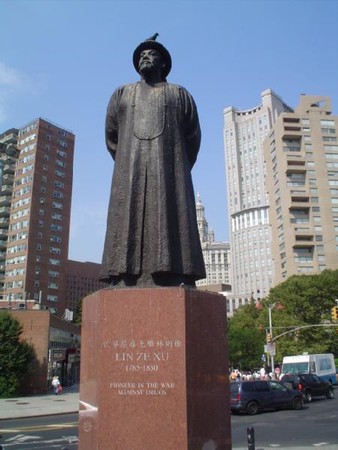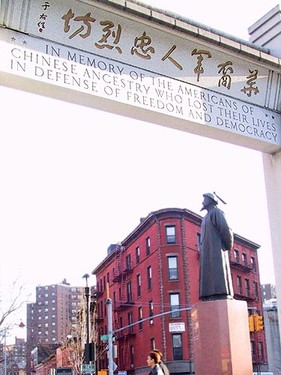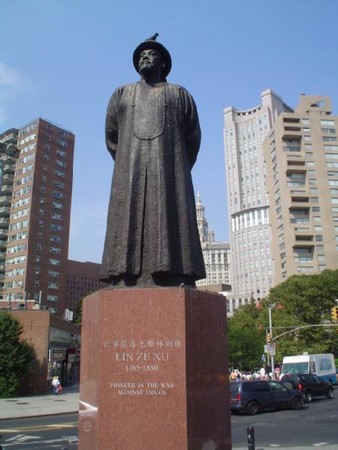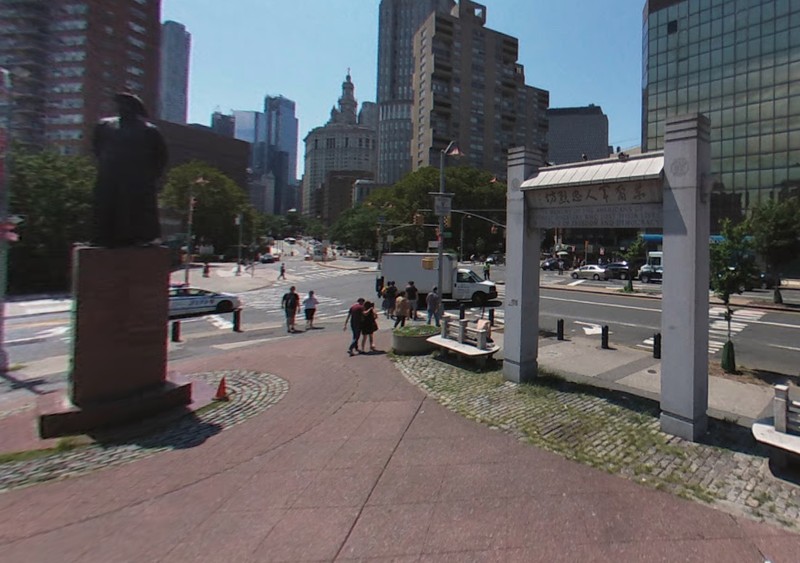The Lt. B.R. Kimlau Chinese Memorial and the Statue of Lin Zexu
Introduction
Text-to-speech Audio
Images
Inscription: Lin Ze Xu 1785 -1850 Pioneer in the war against drugs (image from http://www.nycgovparks.org/parks/kimlau-square/monuments/1979)

Lin Zexu memorial statue in background, with nearby Americans of Chinese Ancestry memorial arch in foreground (image from http://www.nychinatown.org/chatham.html).

Lin Zexu memorial statue

Americans of Chinese Ancestry memorial arch and the Statue of Lin Zexu

Backstory and Context
Text-to-speech Audio
Second Lieutenant Benjamin Ralph Kimlau (1918-1944) was a Chinese American bomber pilot who died serving his country in World War II. Born in Concord, Massachusetts, Kimlau moved to New York City with his parents when he was fourteen. After he graduated from high school in 1937, Kimlau first traveled to China, where he witnessed firsthand Japanese military aggression. The next year, he returned to the U.S. and entered the Pennsylvania Military College (now the United States Army War College).[1] Interested in airborne defense, Kimlau joined Air Force and embarked on a mission to bomb Japanese airbases around New Guinea. On March 1944, Japanese defenders shot down his bomber and killed him.
In order to provide an everlasting memorial for those Chinese-Americans who had answered the call of our nation and provided the supreme sacrifice, the Lt. Kimlau Post petitioned the City of New York in 1958 for a site at Chatham Square to build a memorial. After many delays and rejections, the Post finally obtained permission in early 1961 to change the name of “Chatham Square” to “Kimlau Square” and erected a memorial to honor all Chinese-Americans who died while serving our nation. On April28, 1962, an unveiling ceremony for the memorial was conducted with a parade and a big celebration afterward. [2]
Designed by architect Poy G. Lee (1900-1968), this
Asian-inspired architecture reflects the character of the area, in the Manhattan’s
Chinese community. Inscribed on the nearly 19-foot-high arch is a dedication in
both English and Chinese to the memory of Chinese Americans who died while
serving during WWII. The arch also serves as the site of an annual celebration
to honor war veterans.[3]
Lin Zexu, leading Chinese scholar and official of the Qing dynasty, is known for his role in the events leading up to the first Opium War between Britain and China. He was a proponent of the revitalization of traditional Chinese thought and institutions, a movement that became known as the Self-Strengthening Movement.[4] The placement of the statue was carefully planned: Lin faces Northeast and East Broadway, which some people call “Fuzhou Street” because of the prevalence of Fujianese. In 1997, after the statue was displayed, a journalist said the statue carries a strong political message, “it underscores the ascending power in Chinatown of immigrants from mainland China, particularly the Fujianese. They are quickly gaining political strength, at the expense of the pro-Taiwan Cantonese who settled earlier in Chinatown.”[5]
By comparison, the Confucius statue was financed primarily by money from Taiwan’s Nationalist Government, and the green marble base of Confucius was mined in Taiwan; the Lin Zexu statue was founded by Fujianese individuals and civic associations, and the red granite base of Lin Zexu was mined in Xiamen, a major city of Fujian.[6] People from CCBA suspected politics might have been a factor, but one should not read too much into the divergence, while acknowledging underlying competition among different groups of Chinese Americans.
Sources
[1] https://www.nycgovparks.org/parks/kimlau-square/history
[2]http://www.ltkimlau.com/post-history/history-of-post-1291
[3] https://www.nycgovparks.org/parks/kimlau-square/highlights/12354
[4] https://www.britannica.com/biography/Lin-Zexu
[5] http://www.nytimes.com/1997/11/20/nyregion/chinatown-s-fujianese-get-a-statue.html
[6] http://www.nytimes.com/1997/11/20/nyregion/chinatown-s-fujianese-get-a-statue.html
